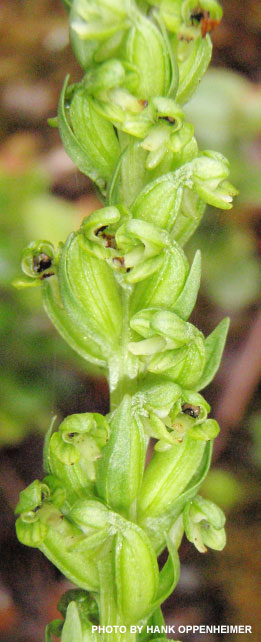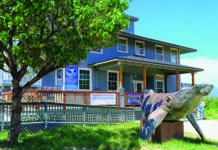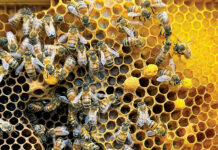Story by Peter von Buol | Photograph by Hank Oppenheimer
 Some of the world’s most delicate-looking and showy orchids grow in our islands, yet only three are native to the archipelago. Of these, the Hawaiian fringed orchid (Platanthera holochila) is the most rare.
Some of the world’s most delicate-looking and showy orchids grow in our islands, yet only three are native to the archipelago. Of these, the Hawaiian fringed orchid (Platanthera holochila) is the most rare.
Unlike its commercially cultivated relatives, the Hawaiian fringed orchid (also known as the Hawaiian bog orchid) blends in easily with its surroundings. A terrestrial plant, it grows in the soil, emerging from underground tubers as a long green stem with pale-green, egg-shaped leaves, and flowers with a subtle greenish-yellow hue.
Dr. Steven Perlman, a field biologist formerly with the National Tropical Botanical Gardens, has been working to protect Hawai‘i’s endangered species for more than forty years. “I first saw P. holochila on a hike to Mt. Wai‘ale‘ale on Kaua‘i in 1978,” he recalls. “I think it had not been seen on Kaua‘i since 1917. In the 1980s, I saw it on Kamakou [Moloka‘i’s highest peak], and much later we found it on Maui.”
Only about two-dozen individuals have been located in the wild. For years, Perlman collected their seeds and tried — unsuccessfully — to germinate them. Help arrived in the person of Dr. Lawrence Zettler, head of biology at Illinois College. Zettler studies Platanthera; his lab has a special incubator that can mimic specific growing conditions, such as temperature, soil pH and length of day.
One of P. holochila’s closest cousins is the Alaskan fringed orchid. As seeds, it may have hitched a ride south on the wings of a kolea, the Pacific golden plover, which migrates from Alaska to Hawai‘i in winter. John Bates, associate curator of birds at Chicago’s Field Museum, says other species could also have provided transportation: “Curlews, geese and ducks get to Hawai‘i occasionally. This year a snowy owl made it.”
Zettler suspects the Hawaiian fringed orchid has been hard to grow because experts assumed it would behave like a tropical epiphyte (a plant that grows on other plants without harming them, like orchids that grow on trees). Zettler’s team took the same approach to germinating its seeds as they would a temperate variety. “Many terrestrial orchids germinate only in darkness, so we opted for dark incubation.” They also made sure that the growing medium for their test-tube babies would match the high acidity of the boggy soils where P. holochila has been found.
“Once we were able to rear leaf-bearing seedlings,” says Zettler, “we took most of the plants to Anna Palomino at Olinda on Maui, where the higher elevation and cooler temperatures more closely matched the orchid’s natural habitat. It turned out that she was the perfect grower. At least two of our seedlings have since flowered.”





